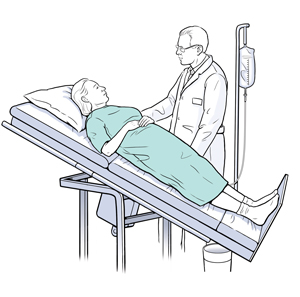Tilt Table Testing
Tilt Table Testing
Tilt table testing is a simple test that helps the doctor identify the cause of your fainting. It checks how changes in body position can affect your blood pressure and heart rate. To do this, you are placed on a table that is tilted upward. The test tries to recreate fainting symptoms while your blood pressure and heart rate are monitored. The test can be done in a hospital or at your doctor’s office.
Before your test
For best results, prepare for the test as directed. Keep in mind:
When you schedule the test, be sure to mention all the medicines you take. Ask if you take them the day of the test.
Arrange for a ride home after the test.
After the midnight before the test, don’t eat or drink anything.
On the day of the test, dress for ease and comfort. Wear a two-piece outfit, top and bottoms. You will need to undress from the waist up and put on a short hospital gown.
During your test
Tilt table testing takes about 60 minutes. The testing room is kept quiet and dimly lit. During the test:
Small pads (electrodes) are put on your chest to monitor your heartbeat.
A blood pressure cuff is put on your arm.
An IV (intravenous) line may be placed in your other arm. The IV line delivers fluids and medicine if needed.
You’ll be asked to lie flat on the table. Your upper body and thighs will be held in place with straps.
Baseline vital signs are recorded such as blood pressure, breathing rate, and pulse.
The table tilts until you are almost standing upright. Heart rate and blood pressure are continuously monitored. Any changes in these readings or any symptoms that develop are recorded.
You’ll remain upright for up to 60 minutes. In most cases, the test is over in 30 to 45 minutes.
Sometimes the technician or healthcare provider may rub the arteries in your neck to check for a fainting reflex.
Occasionally, people are given certain IV medicines to stimulate heart rate and heart pumping and then are retested. These medications may make you feel shaky or anxious.
After your test
Any medicines used during the test should leave your system within 15 minutes. If you were told to skip daily medicines before the test, ask if you should start taking them again. You’re likely to be sent home right away. It’s a good idea to have a friend or family member drive. If you fainted during the test, you may want to rest for a few hours once you’re home.
Report any symptoms you have during the test
Let the doctor or technician know if you notice:
Feeling like you are going to faint
Overall weakness
Nausea
Dimmed vision
Sweating, dizziness, or lightheadedness
A rapid heartbeat
Chest pain
Any other symptoms
Updated:
August 04, 2018
Sources:
Upright tilt table testing in the evaluation of syncope, Up To Date
Reviewed By:
Image reviewed by StayWell medical illustration team.,Kang, Steven, MD,Snyder, Mandy, APRN
